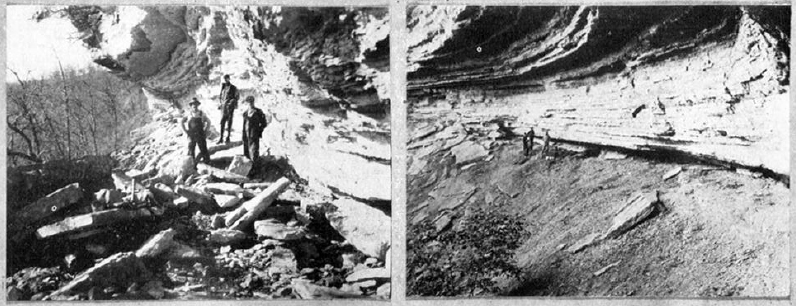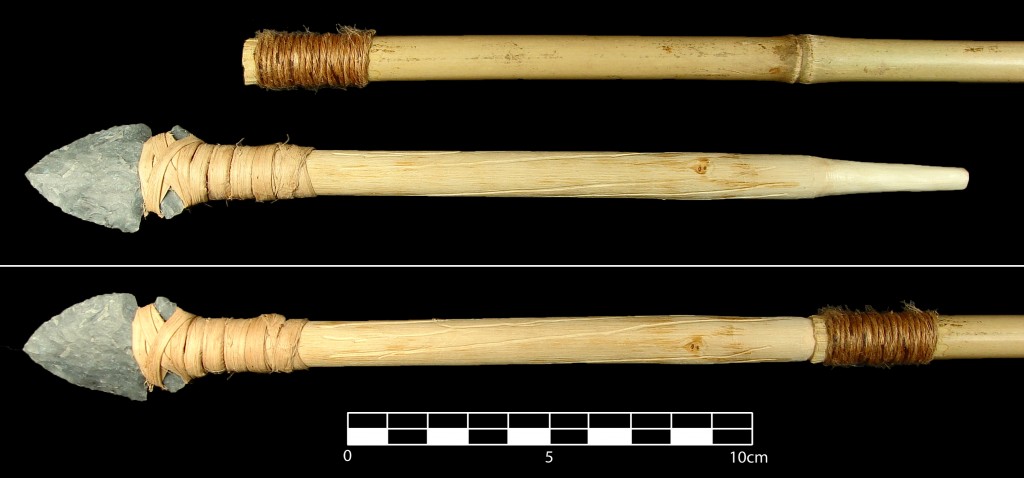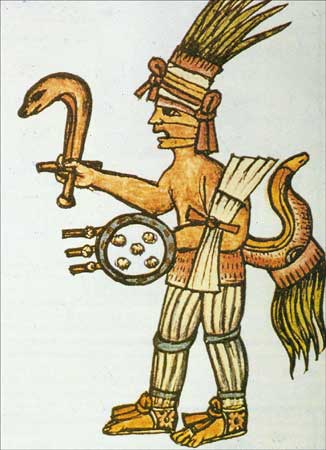Reproducing the Cross-peg Atlatl from Arkansas
By Devin Pettigrew
12/30/2011
Who could picture the spectacular glories of the culture developed by the native groups of the Northwest Coast—the totem poles, the huge houses with their elaborate carvings and paintings, the fantastic masks, the great canoes, all of wood, if some cataclysm had wiped out the people before the white man came? Nothing would remain to us but their products in stone, bone, copper and shell, which were few and relatively simple. ~Harrington (1960)
In the 1920’s and 30’s M.R. Harrington of the Museum of the American Indian traveled to Northwest Arkansas to conduct investigations under the bluffs. Having heard of local finds of perishable artifacts, Harrington was the first archeologist to realize the potential of the Ozark bluffs, which remain today the best place in North America east of the Rockies for the preservation of organic artifacts. Unfortunately most bluffs remain unstudied, and have been and continue to be pilfered by looters. However, early explorations by Harrington and others have provided a small sample of the perishable materials of prehistoric Ozark cultures.
Figure 1 – Harrington and crew (1924, Plate I) during early excavations under Arkansas Bluffs.
Much of Harrington’s work was done along the White River, on what is now Beaver Reservoir. Here a certain kind of atlatl made simply of a branch with a forked limb and a peg grip was discovered. Though Harrington writes that one whole and several fragmentary examples were discovered, he lists only two; the whole atlatl from Allred (Alred) shelter (1960, Plate XV a; Cat. 117326.000), and a distal end from Breckenridge (1960, Figure 12 a; Cat. 115915.000) about 7 miles downstream from Alred as the crow flies. For a long time the Alred atlatl remained a cloistered example of this atlatl type, however recent investigation reveals its presence in artifacts and rockart from Texas, New Mexico, and Northern Mexico. And as Harrington himself realized, Mesoamerican groups also employed this atlatl type, possibly until the draining of Lake Texcoco in the early 20th century (Pettigrew 2012:9-16).
Despite its simple design, reconstructing the Alred atlatl has proven challenging. The natural diameter of the peeled limb is slightly wider at the spur than the shaft proximal to it, which in conjunction with the flow of the grain indicates that the spur was somehow placed at the base of an offshoot branch or fork in the limb (this is more apparent on the Breckenridge fragment, though the Alred atlatl shows the same production techniques). Such a method of spur formation is also seen on an artifact from Frightful Cave in Northern Mexico (Taylor 1966, Figure 12 a). Subsequently, much time was spent searching for the proper limb to produce such an atlatl, following the criteria of an offshoot branch coming out at the proper angle, followed by a fairly straight shaft (which could be straightened with heat) and few or no branches for a given length, and also a grain that matched the artifact in appearance. Other characteristics I looked for were bark that could be peeled or scraped away fairly easily, and wood that cracks very little as it dries.
Dimensions of the Alred Atlatl (NMAI Cat. 117236.000)
| Length overall | 49.8 cm (19.6 in) |
| from proximal end to peg | 9 cm (3.5 in) |
| from spur tip to distal end | 4.5 cm (1.8 in) |
| of cross peg | 4.9 cm (1.9 in) |
| Thickness of distal end at spur | 2.6 cm (1 in) |
| of shaft at center | 1.8 cm (0.7 in) |
| Height of working spur | 5.5 mm (0.2 in) |
Dimensions are close approximations taken from high quality scaled photographs of the artifact, compliments of the Museum of the American Indian.
Finally I searched out ozark chinquapin (Castanea ozarkensis), the famous chestnut tree of the Ozarks, which in the 1950’s and 60’s was all but wiped out by the chestnut blight. A few struggling saplings still remain in the hills, and a branch of one of these produced the closest match to the original I’ve yet come up with (figure 2). For future reconstructions it is important to search out trees already badly struck with the blight, or minimize damage to healthy trees when using ozark chinquapin. For more information see: http://www.ozarkchinquapin.com/.
Figure 2 – Replica of the Alred atlatl in Ozark chinquapin (Castenea ozarkensis)
Although Harrington also writes that river cane (Arundinaria gigantea) dart shafts were found under the bluffs, he depicts only one potential proximal fragment (1960, Figure 12 b; Cat. 120195.000). However, a complete dart foreshaft from Bushwack shelter, just a couple of hundred yards downstream from Alred, and another from Alred (1924, Plate II b; Cat. 116164.000 & 117332.000) exhibit proximal ends consistent with what modern atlatlists have produced independently for cane darts. This consists of a gradual or non-tapering seating cone with a more sharply angled shoulder at the top, which seats into the socket of a naturally hollow mainshaft which is reamed out at the top (figure 3). The purpose of this reaming is to produce some give in the joint, which with a tight whipping, allows the foreshaft to be wedged firmly into the socket (Mills 2009).
Figure 3 – Reproduction of a dart foreshaft with a long, seating cone meant for a cane dart, and a corner notched point hafted with willow bark
If the foreshaft is too small in diameter it may split the mainshaft—too large and it may not seat correctly and will fall out in flight. Therefore, considering the diameters of these foreshafts along with the height of the spur on the Alred atlatl, it is possible to form an estimate of dart size. What subsequently arises is a fairly small, light dart similar to the caliber of Late Archaic darts from western North America. Such a dart balances and functions well with a close replica of the Alred atlatl (figure 4). The approximate dimensions for such a dart are, speculatively, 0.8 cm proximally to 1.2 cm distally, at around 1.6 meters overall length.
Figure 4 – The author holding a complete Alred atlatl and dart system
Also of note is that the potential proximal dart fragment would have a nock formed by sawing a ring around the middle of a segment, and snapping off the end. The base of the nock is then abraded to give purchase for a supportive wrapping. Such a hollow nock functions well, and is much easier to produce with stone tools than attempting to place the nock at a solid node wall, as is the common modern practice when producing mainshafts of this material. Stone points used with the foreshaft type in question are corner notched; of the Snyders or Williams variety. These appear to have been hafted with strips of bark, as the foreshafts and points from other White River bluffs with bark hafting remnants attest. Experiments have shown that willow and other barks are easily procured and processed, and produce adequate hafts for point delivery. After stripping the bark, allow it to dry, then re-soak and scrape off the outer layer before attempting to haft with it. As it dries the second time, the bark will harden and constrict. Whether or not these darts were fletched we can’t be sure. The best evidence comes from the Red Linear rock art from the Guadalupe Mountains and Lower Pecos (Billo et al. 2011), in which similar cross-peg atlatls and darts are depicted. Though these images are small, they are detailed, and no fletches are depicted on the darts.
Finally, the cross-peg grip has produced something of a quandary for modern atlatlists. Many have found its use uncomfortable or confusing. However, thanks to the Aztec codices in which these atlatls are often stylistically yet intricately depicted in the hands of gods and warriors, the method of gripping can be reproduced. The codices most frequently show a hammer-grip, with the index finger hooked over one peg and the thumb pressed against the other (figures 5 & 6). With a proper balance between the dart and atlatl the last three fingers of the gripping hand can rest loosely over and alongside the lower handle in holding and throwing, and the peg becomes the fulcrum point of the grip. This orients the wrist for a higher range of motion, and allows the cast to be made with a more relaxed wrist, as with many other North American Archaic atlatl artifacts.
Figure 5 – The Aztec war god Huitzilopochtli holding a cross-peg serpent atlatl
Figure 6 – Reproducing the method of gripping the Alred atlatl
The Bluff-dweller atlatls seem to have roots in a minimalistic design with a range spanning, conservatively, from the Ozarks to the Southwest and down into Mesoamerica. Archeological and historical evidence suggests it may have lasted from the Middle Archaic until the early 20th century. Reproducing the Alred atlatl, and examining the dart foreshafts which most likely were used with the Ozark cross-peg atlatls to form the best estimate of accompanying dart caliber is beginning to reveal its hidden, and thus far, we feel, misunderstood functionality.
References:
Billo, Evelyn, Robert Mark, and John Greer
2011 Hunters Shelter and White Oaks Spring Pictographs: Pecos Miniature Art in the Guadalupe Mountains of Southern New Mexico. American Indian Rock Art, 37:39-74.
Harrington, Mark R.
1924 The Ozark Bluff Dwellers. American Anthropologist n.s. 26(1):1-21.
1960 The Ozark Bluff Dwellers. Indian Notes and Monographs 12. Museum of the American Indian Heye Foundation, New York.
Mills, Tom
2009 Making a Rivercane Atlatl Dart. The Atlatl 22(2):1-7.
Pettigrew, Devin B.
2012 Bluff-Dweller Atlatls: An Old Find Rediscovered and New Interpretations. In Prep. World Atlatl Association Webpage. (http://www.worldatlatl.org/).
Taylor, Walter W.
1966 Archaic Cultures Adjacent to the Northeastern Frontiers of Mesoamerica. In Handbook of Middle American Indians, edited by Walter Wauchope, 4:59-94. University of Texas Press, Austin.








6 Responses to Ozark Bluff-dweller, Alred Shelter, Arkansas